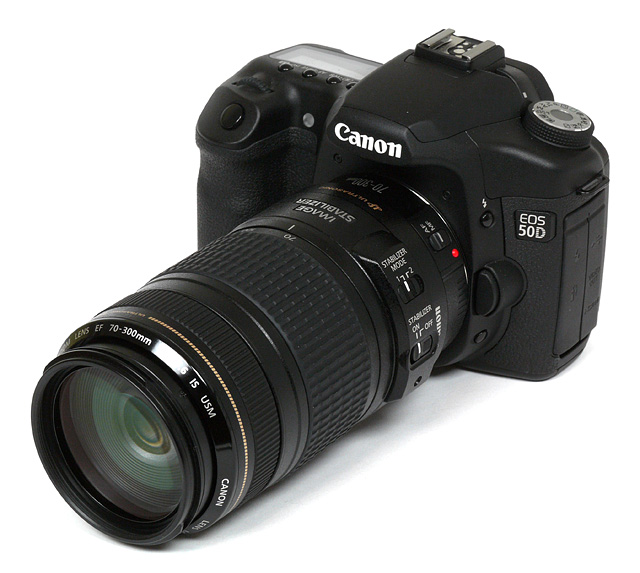|
Canon EF 70-300mm f/4-5.6 USM IS - APS-C Format Review / Retest |
|
Lens Reviews -
Canon EOS (APS-C)
|
|
Page 1 of 2

Review by Klaus Schroiff, published December 2010
Lens kindly provided for testing purposes by Christoph Siegwart!
Introduction
The Canon EF 70-300mm f/4-5.6 USM IS is one of the older IS lenses available today.
It replaced the old EF 75-300mm f/4-5.6 USM IS which was the first Canon IS lens to hit the
market back in 1995. We provided a test report in the APS-C scope (@ 8mp) already but we'd like to
give you an update on a higher mega-pixel body now. APS-C Canon DSLRs have a 1.6x sensor multiplier
in terms of field-of-view so this translates a focal length range equivalent to a "112-480mm" lens
on a full format body. Typical applications for such a lens are sports or wildlife photography.
 Compared to its predecessor it has been improved in a number of aspects. The most significant
change is a redesign of the optical construction which now features a UD element.
The AF speed has been significantly improved to a very decent level although it doesn't quite
reach the speed of Canon's ring-type USM lenses. Thanks to a micro-USM drive the noise level
is very low. The lens does not feature FTM (full-time manual focusing in AF mode) though.
Compared to its predecessor it has been improved in a number of aspects. The most significant
change is a redesign of the optical construction which now features a UD element.
The AF speed has been significantly improved to a very decent level although it doesn't quite
reach the speed of Canon's ring-type USM lenses. Thanks to a micro-USM drive the noise level
is very low. The lens does not feature FTM (full-time manual focusing in AF mode) though.
One key selling factor for this lens is naturally the Image Stabilizer (IS). Camera motion is detected
by 2 gyro sensors which measure the angle and speed of the shake. This information is used to shift
a lens group off the optical axis (basically a forced decentering) to counteract this motion.
The result is a significant improvement of handholdibility under extreme conditions.
Canon improved the efficiency of the mechanism to an equivalent of 3 f-stops (up from 2 f-stops).
The IS now offers 2 different modes (instead of just one):
- mode (1) for static scenes where the IS corrects shake both vertically as well as horizontally
- mode (2) for action photography (object tracking) where only vertical shake is corrected

The build quality of the lens is about average. Neither the focus nor the zoom control ring is
especially damped but it operates quite smooth. The various switches feel a little cheap. As you
can see in the product shot below the lens extends significantly during zooming (typical in the lens
class) and the front element rotates during focusing operations so using a polarizer is a little
cumbersome at best. Another new feature is a transport lock that prevents zoom creeping.
Here's a comparison with its nearest cousins:
|
Canon
EF 70-300mm f/4.5-5.6
USM DO IS |
Canon
EF 70-300mm f/4-5.6
USM IS |
Tamron
AF 70-300mm f/4.5-5.6
VC USD |
| design: |
18 elements in 12 groups, 1x DO element |
15 elements in 10 groups, 1x UD element |
17 elements in 12 groups, 1x LD + 1x XLD element |
| size: |
82x100mm |
77x143mm |
82x143mm |
| weight: |
720g |
630g |
765g |
| image stabilizer efficiency: |
3 f-stops, 2 modes |
3 f-stops, 2 modes |
4 f-stops |
| aperture blades: |
6 |
8 |
9 |
| min. focus: |
1.4m |
1.5m |
1.5m |
| filter size: |
58mm |
58mm |
62mm |
| AF motor |
ring-type USM with FTM and non-rotating front element |
micro-USM, no FTM, rotating front element |
USD (Ultrasonic Silent Drive), FTM, non-rotating front element |
| approx price tag: |
1200 EUR/US$ |
450 EUR/US$ |
450 EUR/US$ |
|